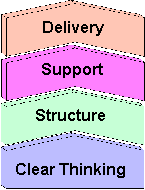
Vision Presentation Skills |
|
| Sometimes preaching
can seem easy compared with presentation skills required to communicate other ideas or
proposals to groups in a different setting. Yet the planning of any form of verbal
communication should have four basic elements irrespective of how long it will last. |
|
| Stage 1 : Clear
Thinking. We've already covered the need to think carefully and clearly about the vision before starting to communicate it. The second component of this stage is to think about the purpose of your presentation. What are you hoping to achieve? Try to write this down in a single sentence. Stage
2 : Presentation Structure. |
|
| Consider who will
be listening to your presentation. What do they know, and how do they feel, about the
content of the presentation? In planning the structure, help them hear what they need to
know, rather than tell them want you want to say! You will also need to choose the length of the presentation and your style - how formal or informal do you want to be? Remember, informal presentations require no less preparation, only a different presentation style. Once you've fixed on a length - stick to it! Stage 3 : Support Materials Any visuals should be kept simple - far too often overhead slides can be cluttered with too much text. One main message per slide is sufficient, with up to four bullet points. Try to build in some colour or some other visual aid to retain attention. Stage 4: Delivery of the Presentation
Consider your tone and stance - what message does your body convey? (Tip : getting someone to watch or even video your rehearsal can pick up unconscious mannerisms!) Check the practicalities - does the OHP work, and is it in focus? Is there a microphone? Can you be heard? |
|

